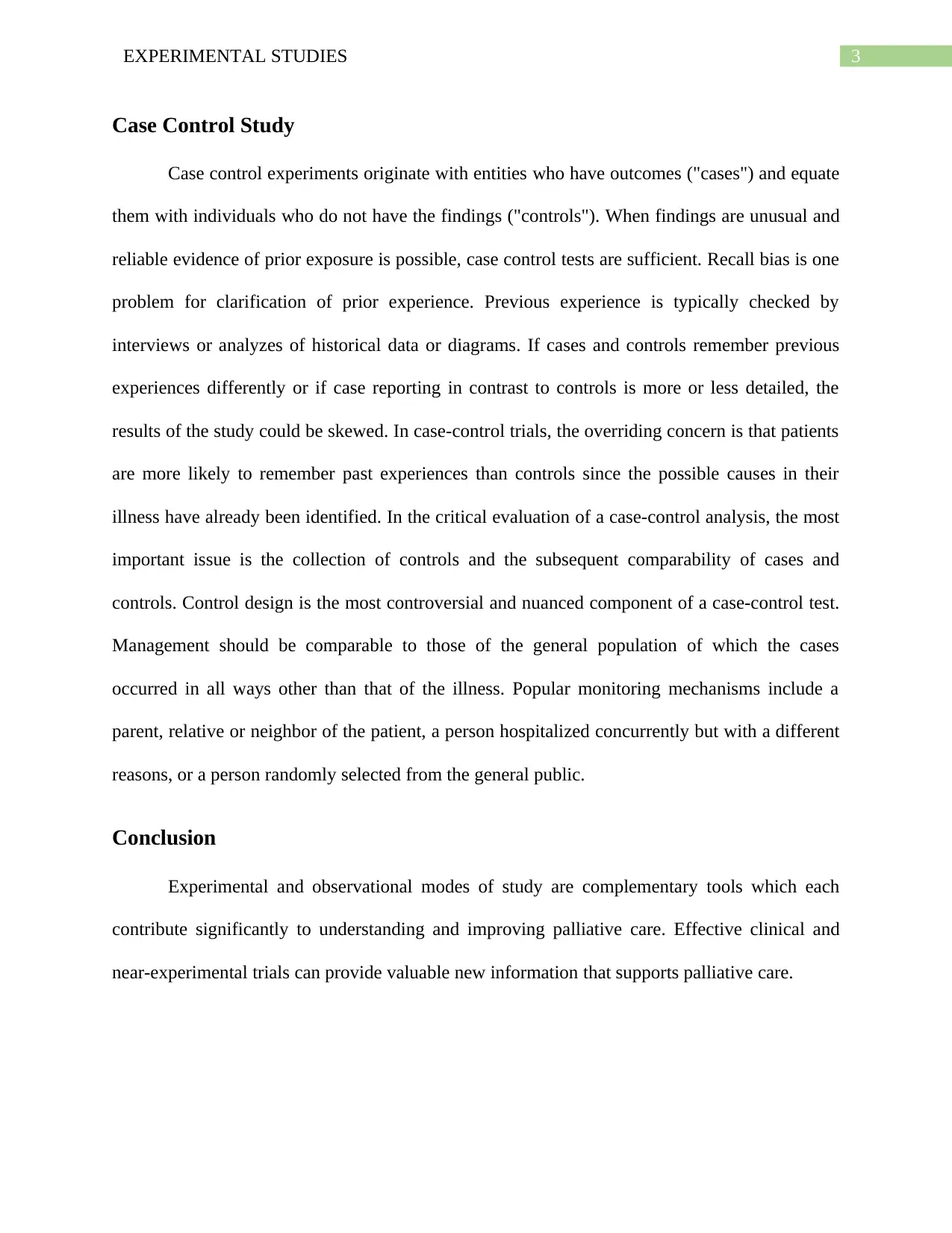Observational Experiments: Cross-Sectional, Cohort, and Case Control
VerifiedAdded on 2022/08/14
|5
|1025
|16
Report
AI Summary
This report provides an overview of observational experiments, crucial for understanding the impact of interventions in healthcare, particularly in palliative care. It delves into three primary observational designs: cross-sectional studies, which offer a snapshot of a population to assess associations; cohort studies, which follow groups over time to determine outcomes related to exposures; and case-control studies, which compare individuals with and without a specific outcome to identify potential risk factors. The report emphasizes the significance of these designs in palliative care research, highlighting their roles in evaluating symptoms, services, and patient outcomes. It also discusses the strengths and limitations of each design, including potential biases and the importance of careful study design and control selection. The conclusion underscores the complementary nature of experimental and observational studies in advancing healthcare knowledge and improving patient care.

Running head: EXPERIMENTAL STUDIES
Observational experiments
Name of the Student:
Name of the University:
Author Note:
Observational experiments
Name of the Student:
Name of the University:
Author Note:
Paraphrase This Document
Need a fresh take? Get an instant paraphrase of this document with our AI Paraphraser

1EXPERIMENTAL STUDIES
Introduction to Observational Experiments
Observational experiments draw inferences about the impact of an "exposure" or
interference on subjects whereby the investigator watches rather than manipulates the assigning
of participants to classes (for example, by randomisation). The empirical observation of people
in their natural environment requires observational work. As such, individual preferences,
patterns of behavior or policy decisions are dictated by who accepts an experiment or not. It is
therefore necessary for observational research readers to consider that possible causes for the
results of the study to arise. Information for observational studies are either obtained from the
researchers for study purposes (primary statistics) or gathered for other purposes, but they are
used by the researchers to study a new research issue (secondary statistics). The significant trade-
offs in time, money and management of research variables between primary and secondary data
use (Mamdani., et al).
Cross-Sectional Study
A cross-sectional analysis is a sample that concurrently decides access and outcomes for
each subject. It is frequently referred to as a "snapshot" of a group of people. Cross-sectional
experiments are suitable for screening theories as they need comparatively less time and less
money to be carried out (Rothman., et al).
Cross-sectional study has been extensively used in studies of palliative care. Diversity of
symptoms, procedures, programs or other effects, and the factors related to these outcomes, have
been evaluated through the cross-sectional studies method. The cross-sectional scope of the
research has been an important way of assessing a large number of hospice patients, identifying
the prevalence of specific services and creating theories of why service provision may be
Introduction to Observational Experiments
Observational experiments draw inferences about the impact of an "exposure" or
interference on subjects whereby the investigator watches rather than manipulates the assigning
of participants to classes (for example, by randomisation). The empirical observation of people
in their natural environment requires observational work. As such, individual preferences,
patterns of behavior or policy decisions are dictated by who accepts an experiment or not. It is
therefore necessary for observational research readers to consider that possible causes for the
results of the study to arise. Information for observational studies are either obtained from the
researchers for study purposes (primary statistics) or gathered for other purposes, but they are
used by the researchers to study a new research issue (secondary statistics). The significant trade-
offs in time, money and management of research variables between primary and secondary data
use (Mamdani., et al).
Cross-Sectional Study
A cross-sectional analysis is a sample that concurrently decides access and outcomes for
each subject. It is frequently referred to as a "snapshot" of a group of people. Cross-sectional
experiments are suitable for screening theories as they need comparatively less time and less
money to be carried out (Rothman., et al).
Cross-sectional study has been extensively used in studies of palliative care. Diversity of
symptoms, procedures, programs or other effects, and the factors related to these outcomes, have
been evaluated through the cross-sectional studies method. The cross-sectional scope of the
research has been an important way of assessing a large number of hospice patients, identifying
the prevalence of specific services and creating theories of why service provision may be

2EXPERIMENTAL STUDIES
different in hospitals. Thus definitions of cross-sectional designs for palliative care research
include the combination of caring characteristics and the role of carers of terminally ill patients
(e.g. sociodemographics; presence of social networks) and the combination of medical
characteristics (e.g. age, gender, profession, board of education, hospital knowledge).
Cohort Study
A cohort design is distinguished by the time-long follow-up of the participants. Cohort
Studies of the samples begin with individuals whose element is exposed and not exposed to
variable factors and determine the effect based on the outcome. Cohort studies can be parallel or
longitudinal, and this is when the participants have been established in relation to the current
date. Cohort studies are an adequate research style, where the correlation between an exposure
and an outcome is strong (perhaps through tentative cross-cutting tests); the time between
exposure, and the outcome's growth, is fairly short to mitigate the lack of followup. The
retrospective study design results from being able to examine development, level and natural
history because the investigator recognizes recent or "incident" outcomes. Cohort designs
may generate both incident and relative hazards, and cohort studies may determine causality
because of the time duration of the study design. The influence of palliative care interventions
was most effective in cohort studies (Gelfman et al.,). In so-called "quasi-experimental" trials,
observational studies are commonly used in palliative care science. These cohort studies blend
empirical and quantitative forms of study. Quasi-experimental strategies are similar to
experimental designs because there is a particular investigator-defined intervention in the
"exposed" community in the study. Individuals who have or do not have involvement (or
exposure) are simply observed and outcomes are ultimately assessed.
different in hospitals. Thus definitions of cross-sectional designs for palliative care research
include the combination of caring characteristics and the role of carers of terminally ill patients
(e.g. sociodemographics; presence of social networks) and the combination of medical
characteristics (e.g. age, gender, profession, board of education, hospital knowledge).
Cohort Study
A cohort design is distinguished by the time-long follow-up of the participants. Cohort
Studies of the samples begin with individuals whose element is exposed and not exposed to
variable factors and determine the effect based on the outcome. Cohort studies can be parallel or
longitudinal, and this is when the participants have been established in relation to the current
date. Cohort studies are an adequate research style, where the correlation between an exposure
and an outcome is strong (perhaps through tentative cross-cutting tests); the time between
exposure, and the outcome's growth, is fairly short to mitigate the lack of followup. The
retrospective study design results from being able to examine development, level and natural
history because the investigator recognizes recent or "incident" outcomes. Cohort designs
may generate both incident and relative hazards, and cohort studies may determine causality
because of the time duration of the study design. The influence of palliative care interventions
was most effective in cohort studies (Gelfman et al.,). In so-called "quasi-experimental" trials,
observational studies are commonly used in palliative care science. These cohort studies blend
empirical and quantitative forms of study. Quasi-experimental strategies are similar to
experimental designs because there is a particular investigator-defined intervention in the
"exposed" community in the study. Individuals who have or do not have involvement (or
exposure) are simply observed and outcomes are ultimately assessed.
⊘ This is a preview!⊘
Do you want full access?
Subscribe today to unlock all pages.

Trusted by 1+ million students worldwide

3EXPERIMENTAL STUDIES
Case Control Study
Case control experiments originate with entities who have outcomes ("cases") and equate
them with individuals who do not have the findings ("controls"). When findings are unusual and
reliable evidence of prior exposure is possible, case control tests are sufficient. Recall bias is one
problem for clarification of prior experience. Previous experience is typically checked by
interviews or analyzes of historical data or diagrams. If cases and controls remember previous
experiences differently or if case reporting in contrast to controls is more or less detailed, the
results of the study could be skewed. In case-control trials, the overriding concern is that patients
are more likely to remember past experiences than controls since the possible causes in their
illness have already been identified. In the critical evaluation of a case-control analysis, the most
important issue is the collection of controls and the subsequent comparability of cases and
controls. Control design is the most controversial and nuanced component of a case-control test.
Management should be comparable to those of the general population of which the cases
occurred in all ways other than that of the illness. Popular monitoring mechanisms include a
parent, relative or neighbor of the patient, a person hospitalized concurrently but with a different
reasons, or a person randomly selected from the general public.
Conclusion
Experimental and observational modes of study are complementary tools which each
contribute significantly to understanding and improving palliative care. Effective clinical and
near-experimental trials can provide valuable new information that supports palliative care.
Case Control Study
Case control experiments originate with entities who have outcomes ("cases") and equate
them with individuals who do not have the findings ("controls"). When findings are unusual and
reliable evidence of prior exposure is possible, case control tests are sufficient. Recall bias is one
problem for clarification of prior experience. Previous experience is typically checked by
interviews or analyzes of historical data or diagrams. If cases and controls remember previous
experiences differently or if case reporting in contrast to controls is more or less detailed, the
results of the study could be skewed. In case-control trials, the overriding concern is that patients
are more likely to remember past experiences than controls since the possible causes in their
illness have already been identified. In the critical evaluation of a case-control analysis, the most
important issue is the collection of controls and the subsequent comparability of cases and
controls. Control design is the most controversial and nuanced component of a case-control test.
Management should be comparable to those of the general population of which the cases
occurred in all ways other than that of the illness. Popular monitoring mechanisms include a
parent, relative or neighbor of the patient, a person hospitalized concurrently but with a different
reasons, or a person randomly selected from the general public.
Conclusion
Experimental and observational modes of study are complementary tools which each
contribute significantly to understanding and improving palliative care. Effective clinical and
near-experimental trials can provide valuable new information that supports palliative care.
Paraphrase This Document
Need a fresh take? Get an instant paraphrase of this document with our AI Paraphraser

4EXPERIMENTAL STUDIES
References
Mamdani, Muhammad, et al. "Reader's guide to critical appraisal of cohort studies: 2. Assessing
potential for confounding." Bmj 330.7497 (2005): 960-962.
Rothman, Kenneth J., Sander Greenland, and Timothy L. Lash, eds. Modern epidemiology.
Lippincott Williams & Wilkins, 2008.
Gelfman, Laura P., Diane E. Meier, and R. Sean Morrison. "Does palliative care improve
quality? A survey of bereaved family members." Journal of pain and symptom management 36.1
(2008): 22-28.
References
Mamdani, Muhammad, et al. "Reader's guide to critical appraisal of cohort studies: 2. Assessing
potential for confounding." Bmj 330.7497 (2005): 960-962.
Rothman, Kenneth J., Sander Greenland, and Timothy L. Lash, eds. Modern epidemiology.
Lippincott Williams & Wilkins, 2008.
Gelfman, Laura P., Diane E. Meier, and R. Sean Morrison. "Does palliative care improve
quality? A survey of bereaved family members." Journal of pain and symptom management 36.1
(2008): 22-28.
1 out of 5
Related Documents
Your All-in-One AI-Powered Toolkit for Academic Success.
+13062052269
info@desklib.com
Available 24*7 on WhatsApp / Email
![[object Object]](/_next/static/media/star-bottom.7253800d.svg)
Unlock your academic potential
Copyright © 2020–2025 A2Z Services. All Rights Reserved. Developed and managed by ZUCOL.





